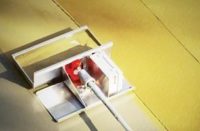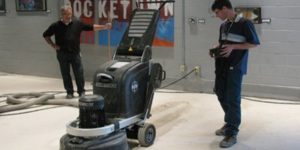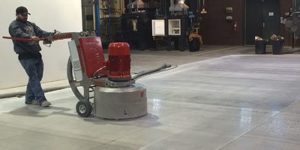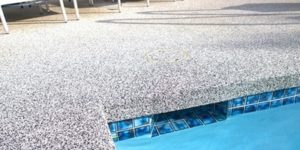 Half of all slips and falls are caused by the floor itself. So reports the National Floor Safety Institute. Still, while most contractors are aware of the problem, they find the subject confusing. And that’s really not surprising, especially as it regards decorative concrete.
Half of all slips and falls are caused by the floor itself. So reports the National Floor Safety Institute. Still, while most contractors are aware of the problem, they find the subject confusing. And that’s really not surprising, especially as it regards decorative concrete.
Part of the problem has to do with standards for slip resistance: Who has guidelines and which ones do you use for decorative concrete? Then there is the testing aspect: Which testing methods are appropriate and reliable, and in what testing conditions?
How slip resistance is rated
Slips occur when there is too little friction between the bottom of a person’s foot and the surface of the floor. The amount of direct contact is very important.
The most common measure of the relative slipperiness of a floor is its slip resistance, or coefficient of friction. This scale ranges from zero to one, in increments of tenths of a point, with zero representing the least amount of slip resistance.
According to Dianne Carey, a chemist with W.R. Meadows, the Occupational Safety and Health Administration’s recommendation is that walking surfaces have a minimum Static Coefficient of Friction of 0.5. But there are more stringent standards, she says. The Americans with Disabilities Act guidelines recommend 0.6 for level surfaces and 0.8 for ramps. “The higher the number, the more ‘friction’ is present,” Carey explains.
 ASTM has several standards for slip resistance. Chris Sullivan, regional sales manager for QC Construction Products, says the age-old ASTM standard for testing slip resistance of floor sealers, coatings and polishes has been ASTM D2047. But this standard has limitations, he says, because it only tests smooth, dry surfaces in laboratory conditions. “No one slips and falls because a sealed surface was dry, which means this standard has very little correlation to real-world situations.”
ASTM has several standards for slip resistance. Chris Sullivan, regional sales manager for QC Construction Products, says the age-old ASTM standard for testing slip resistance of floor sealers, coatings and polishes has been ASTM D2047. But this standard has limitations, he says, because it only tests smooth, dry surfaces in laboratory conditions. “No one slips and falls because a sealed surface was dry, which means this standard has very little correlation to real-world situations.”
In recent years, two ‘real world’ tests have slowly started to gain favor, ASTM 1679 and ASTM 1677. Both test most any surface, in the field, and both in dry or wet conditions. The difference between the two standards, Sullivan adds, is the type of machine used to perform the test.
Mike Anderson with Artscape Las Vegas also sees problems with ASTM D2047. “While this method is extremely accurate and is commonly referred to in flooring circles,” he says, “it can only be used dry in a controlled laboratory environment and cannot be used in the field on existing surfaces.” The most common method for testing decorative concrete, he says, is ASTM C-1028-96 — Standard Test Method for Determining the Static Coefficient of Friction of Ceramic Tile and Other Like Surfaces by the Horizontal Dynamometer Pull-Meter Method.
And therein is the obvious problem, explains Russ Kendzior, president and CEO of the National Floor Safety Institute. “Unfortunately the ASTM has yet to create a slip resistance standard for concrete surfaces. The only standard is that of the NFSI’s 101-A standard, which calls for surfaces to have a wet Static Coefficient of Friction value of 0.6 or greater to be considered ‘High-Traction.’” High-traction surfaces, Kendzior reports, have been clinically proven to reduce slip-and-fall claims by 50 percent to 90 percent.
 Testing slip resistance
Testing slip resistance
Slip resistance can be measured by a variety of machines. The most common type of machine is a tribometer — and there are many versions. You may have heard of the James Machine, Horizontal Pull Slipmeters, Portable Inclinable Articulated Strut Slip Testers or Variable Incidence Tribometers.
Tribometers work by rubbing a pad of some common shoe sole material, such as rubber or leather, over the floor surface, and assessing how hard or easily the pad passes over the surface. This reading results in a Static Coefficient of Friction score, with 0.5 being the national “passing score.”
But, again, the conditions and setting of the testing may offer false security. As Kendzior points out, “Slip resistance can be measured wet or dry; however, since 80 percent of all slips and falls occur on wet surfaces, we believe that wet testing has more significance than dry testing.” The testing device the NFSI recognizes is the BOT-3000 (formerly called the Universal Walkway Tester). “This state-of-the-art robotic tester can measure both the SCOF and DCOF (Dynamic friction) either wet or dry and comes with a wide range of sensor materials which reproduce various shoe materials,” Kendzior explains.
The problem with wet floors
Any wetness introduced between the bottom of the foot and the floor surface decreases or eliminates solid-to-solid contact. No solid contact means little or no friction. And guess what — when that happens, conditions are ripe for slips and falls.
The technical description of what happens when a wet contaminant is pressed between the foot and the floor is “squeeze-film formation.” Things like tread on the soles of shoes helps eliminate the problem in the same way that tread on automobile tires helps vehicles travel on wet roads. If, however, you have no control over the type of shoe people wear, you may have to correct for wet conditions with a degree of surface roughness on the floor itself. If the surface roughness is enough to reach up through the layer of liquid, you’ll have more solid-to-solid contact and more slip resistance.
As this relates to decorative concrete, countermeasures needed depend on the type of decorative finish. And texture is key in improving slip resistance in wet conditions.
Concrete and slip resistance
Decorative concrete surfaces that are stamped or imprinted can be more slip resistant than smooth surfaces, depending on the number of channels in the design and how closely spaced they are. (On the other hand, too much “topography” and you may run into trip hazard issues.)
When it comes to smooth-type finishes, broom-finished floors offer the highest level of slip resistance. Sandblasted surfaces are better than troweled finishes. And, as Sullivan points out, wood is rougher than steel and magnesium, so a wood-troweled finish is a little rougher and more slip-resistant.
The flatness of a floor is a the best indication of how slippery the floor will be, says Phil Smith, vice president and technical director at L&M Construction Chemicals. “The flatter the floor is the more slip-resistant it is, because you have more surface-area contact with the sole of your shoe,” Smith explains. For comparison, he says, an 800-grit polished floor is fairly slip-resistant, whereas a hard-troweled floor can be fairly slippery because the floor surface has small ripples as a result of the troweling process. But, he cautions, a floor may be flatter in some places than others — and flatness should never be confused with levelness. As an example, super-flat floors are both flat and level.
In addition to the surface of the concrete itself, you need to look at the sealer you use.
“Most concrete hardeners and conditioners have little effect on concrete, since they penetrate into the material’s surface,” Kendzior observes. “However, when a topical coating is applied, like a urethane material, the slip resistance results may drop.”
Anderson agrees. A film-forming sealer applied on top of a decorative treatment as a means of protecting the new finish may serve well to protect the finish from damage and/or water intrusion, [but] “it also encapsulates the surface of the concrete, reducing the non-slip characteristics inherent in concrete finishes,” he explains.
Additives can increase slip resistance
There are several additives that can be used to increase slip resistance of a concrete floor. Some are used directly on the concrete, and others can be mixed with or broadcast on top of the sealer.
Some materials, such as aluminum oxide and trap rock, will provide traction if they are sprinkled and troweled onto the surface of concrete while it is still plastic. Smith says that these products are good for small areas and certain situations. For example, he says, aluminum oxide works well on stair treads, while trap rock is good in the threshold of doorways.
Two of the most common sealer additives are silica sand and polymer grit. “They both work the same way,” Sullivan says. “Imagine the top layer of a sealer as a glass-smooth surface, like water on a lake. By adding sand or polymer grit, you are creating thousands of little islands in that lake. These islands stick up above the sealer surface and give the surface more ‘bite’ or traction.”
There are a couple of issues with sand, however. One is the health issues surrounding the use of silica sand. Another is that sand is opaque — you can see it when it is used with a clear sealer. And sand is heavy, tending to fall to the bottom of the sealer coat.
Polymer grit, on the other hand, is clear and is light enough to suspend throughout a sealer coat.
When it comes to pool decks, Anderson turns to another additive: acrylic or polystyrene beads or spheres. “We prefer to use the polystyrene beads around pool decks,” he says. “They have no jagged edges and still provide excellent slip resistance while being less aggressive to feet and swimwear.”
Maintenance and frequent inspections are important
Proper maintenance is just as important to prevent slips and falls as is the flooring material itself. Frequent inspections can help identify high-risk areas and locations where a particular floor material is not being well maintained.
Slip-resistant floors themselves often present additional maintenance issues. For one thing, textured or rough surfaces are tougher to clean and keep clean. And, as Anderson explains, eventually the small beads or mineral additives will wear out or be walked out, leading to sealer breakdown and failure.
When this occurs, a new coat of sealer with grit is required.
But Anderson points out, “Despite all this, our clients believe that the additional cleaning and periodic resealing is a small price to pay when compared to the lawsuits generated by even one slip-and-fall accident.”
For the same reason, Anderson encourages all concrete contractors to talk to their clients upfront about decorative concrete finishes and slip-resistance issues, before the concrete is poured. “This can save a lot of heartache down the road and keep you pouring concrete instead of appearing in court.”















